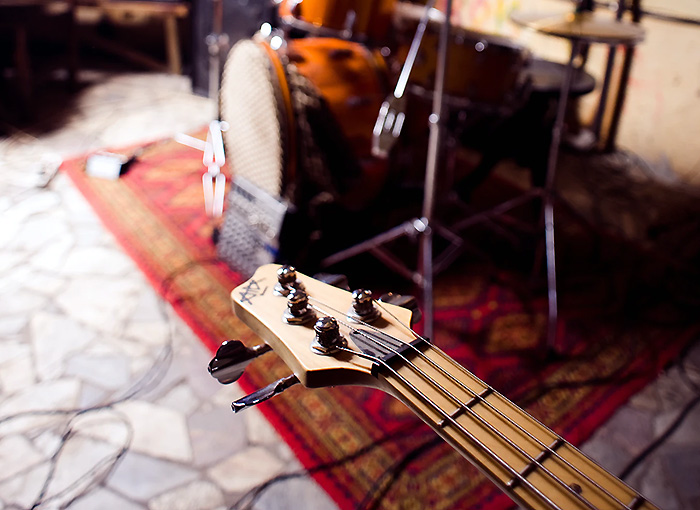.
Perhaps the most difficult task of a mixing engineer is balancing the bass and drums (especially the bass and kick). Nothing can make or break a mix faster than the way these instruments work together.
It’s not uncommon for a mixer to spend hours on this balance (both level and frequency) because if the relationship isn’t correct, then the song will just never sounds big and punchy.
So how do you get this mysterious balance? In order to have the impact and punch that most modern mixes exhibit, you have to make a space in your mix for both of these instruments so they won’t fight each other and turn into a muddy mess.
While simply EQing the bass high and the kick low (or the other way around), might work at it’s simplest, it’s best to have a more in-depth strategy, so consider the following:
1) EQ the kick drum between 60 to 120 Hz as this will allow it to be heard on smaller loudspeakers. For more attack and beater click add between 1 kHz to 4kHz. You may also want to dip some of the boxiness between 200 to 500 Hz.
EQing in the 30 to 60 Hz range will produce a kick that you can feel, but it may also sound thin on smaller loudspeakers and probably won’t translate well to a variety of loudspeaker systems. Most 22-inch kick drums are centered somewhere around 80Hz anyway.
2) Bring up the bass with the kick. The kick and bass should occupy slightly different frequency spaces. The kick will usually be in the 60 to 80 Hz range whereas the bass will emphasize higher frequencies anywhere from 80 to 250 Hz (although sometimes the two are reversed depending upon the song).
Shelve out any unnecessary bass frequencies (below 30 Hz on kick and below 50 Hz on the bass, although the frequency for both may be as high as 60 Hz according to style of the song and your taste) so they’re not boomy or muddy. There should be a driving, foundational quality to the combination of these two together.
A common mistake is to emphasize the kick with either too much level or EQ, while not featuring enough of the bass guitar (see the graphic on the left for a good visual of what it sounds like). This gives you the illusion that your mix is bottom light, because what you’re doing is shortening the duration of the low frequency envelope in your mix.
Since the kick tends to be more transient than the bass guitar, this gives you the idea that the low frequency content of your mix is inconsistent. For pop music, it is best to have the kick provide the percussive nature of the bottom while the bass fills out the sustain and musical parts.
3) Make sure that the snare is strong, otherwise the song will lose its drive when the other instruments are added in. This usually calls for at least some compression, especially if the snare hits are inconsistent throughout the song.
You may need a small EQ boost at 1 kHz for attack, 120 to 240 Hz for fullness, and 10 kHz for snap. As you bring in the other drums and cymbals, you might want to dip a little of 1 kHz on these to make room for the snare. Also make sure that the toms aren’t too boomy (if so, shelve out the frequencies below 60 Hz).
4) If you’re having trouble with the mix because it’s sounding cloudy and muddy on the bottom end, mute both the kick drum and bass to determine what else might be in the way in the low end. You might not realize that there are some frequencies in the mix that aren’t really musically necessary.
With piano or guitar, you’re mainly looking for the mids and top end to cut through, while the low-end is just getting in the way, so it’s best to clear some of that out with a high-pass filter. When soloed, the instrument might sound too thin, but with the rest of the mix the low-end will now sound so much better and you won’t be missing that low end from the other instruments.
Now the mix sounds louder, clearer, and fuller. Be careful not to cut too much from the other instruments, as you might loose the warmth of the mix.
5) For dance music, be aware of kick drum to bass melody dissonance. The bass line over the huge sound systems in today’s clubs is very important and needs to work very well with the kick drum. But if your kick is centered around an A note and the bass line is tuned to A#, it’s going to clash. Tune your kick samples to the bass lines (or vice versa) where needed.
6) If you feel that you don’t have enough bass or kick, boost the level, not the EQ. This is a mistake that everyone makes when their first getting their mixing chops together.
Most bass drums and bass guitars have plenty of low end and don’t need much more, so be sure that their level together and with the rest of the mix is correct before you go adding EQ. Even then, a little goes a long way.
While these aren’t the only mix tips that can help with the bass and drum relationship during your mix (you can check out either The Audio Mixing Bootcamp or The Mixing Engineer’s Handbook for more), they’re a great place to start.
Remember, go easy on the EQ, as a little goes a long way.





















